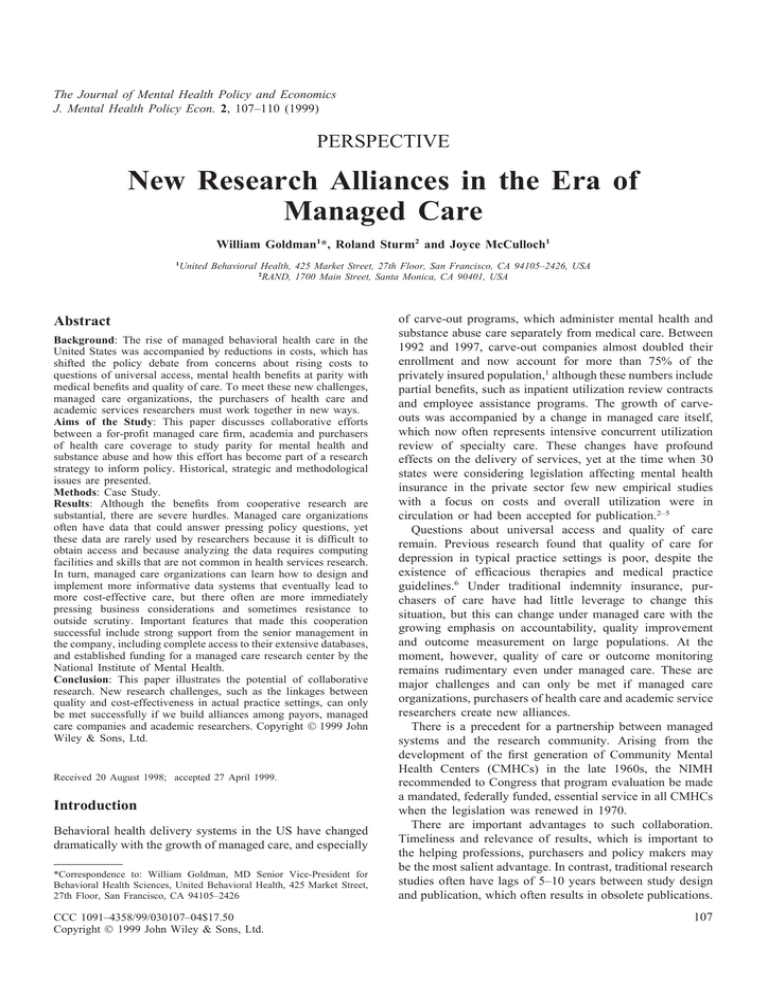New Research Alliances in the Era of Managed Care PERSPECTIVE
advertisement

The Journal of Mental Health Policy and Economics J. Mental Health Policy Econ. 2, 107–110 (1999) PERSPECTIVE New Research Alliances in the Era of Managed Care William Goldman1*, Roland Sturm2 and Joyce McCulloch1 1 United Behavioral Health, 425 Market Street, 27th Floor, San Francisco, CA 94105–2426, USA 2 RAND, 1700 Main Street, Santa Monica, CA 90401, USA Abstract Background: The rise of managed behavioral health care in the United States was accompanied by reductions in costs, which has shifted the policy debate from concerns about rising costs to questions of universal access, mental health benefits at parity with medical benefits and quality of care. To meet these new challenges, managed care organizations, the purchasers of health care and academic services researchers must work together in new ways. Aims of the Study: This paper discusses collaborative efforts between a for-profit managed care firm, academia and purchasers of health care coverage to study parity for mental health and substance abuse and how this effort has become part of a research strategy to inform policy. Historical, strategic and methodological issues are presented. Methods: Case Study. Results: Although the benefits from cooperative research are substantial, there are severe hurdles. Managed care organizations often have data that could answer pressing policy questions, yet these data are rarely used by researchers because it is difficult to obtain access and because analyzing the data requires computing facilities and skills that are not common in health services research. In turn, managed care organizations can learn how to design and implement more informative data systems that eventually lead to more cost-effective care, but there often are more immediately pressing business considerations and sometimes resistance to outside scrutiny. Important features that made this cooperation successful include strong support from the senior management in the company, including complete access to their extensive databases, and established funding for a managed care research center by the National Institute of Mental Health. Conclusion: This paper illustrates the potential of collaborative research. New research challenges, such as the linkages between quality and cost-effectiveness in actual practice settings, can only be met successfully if we build alliances among payors, managed care companies and academic researchers. Copyright 1999 John Wiley & Sons, Ltd. Received 20 August 1998; accepted 27 April 1999. Introduction Behavioral health delivery systems in the US have changed dramatically with the growth of managed care, and especially *Correspondence to: William Goldman, MD Senior Vice-President for Behavioral Health Sciences, United Behavioral Health, 425 Market Street, 27th Floor, San Francisco, CA 94105–2426 CCC 1091–4358/99/030107–04$17.50 Copyright 1999 John Wiley & Sons, Ltd. of carve-out programs, which administer mental health and substance abuse care separately from medical care. Between 1992 and 1997, carve-out companies almost doubled their enrollment and now account for more than 75% of the privately insured population,1 although these numbers include partial benefits, such as inpatient utilization review contracts and employee assistance programs. The growth of carveouts was accompanied by a change in managed care itself, which now often represents intensive concurrent utilization review of specialty care. These changes have profound effects on the delivery of services, yet at the time when 30 states were considering legislation affecting mental health insurance in the private sector few new empirical studies with a focus on costs and overall utilization were in circulation or had been accepted for publication.2–5 Questions about universal access and quality of care remain. Previous research found that quality of care for depression in typical practice settings is poor, despite the existence of efficacious therapies and medical practice guidelines.6 Under traditional indemnity insurance, purchasers of care have had little leverage to change this situation, but this can change under managed care with the growing emphasis on accountability, quality improvement and outcome measurement on large populations. At the moment, however, quality of care or outcome monitoring remains rudimentary even under managed care. These are major challenges and can only be met if managed care organizations, purchasers of health care and academic service researchers create new alliances. There is a precedent for a partnership between managed systems and the research community. Arising from the development of the first generation of Community Mental Health Centers (CMHCs) in the late 1960s, the NIMH recommended to Congress that program evaluation be made a mandated, federally funded, essential service in all CMHCs when the legislation was renewed in 1970. There are important advantages to such collaboration. Timeliness and relevance of results, which is important to the helping professions, purchasers and policy makers may be the most salient advantage. In contrast, traditional research studies often have lags of 5–10 years between study design and publication, which often results in obsolete publications. 107 One example is the continuing stream of studies contrasting ‘prepaid managed’ with unmanaged ‘fee-for-service’ care, which is approaching extinction. Meanwhile, major databases remain untapped and important policy questions go unanswered; this directly affects the US healthcare system because uncertainty reduces the possibility of effective policies and regulation. This lesson was relearned during the 1996 Congressional debates on mental health ‘parity’ (covering mental health care at the same level as medical care). Because no new research was available, the influential cost estimates of parity by the Congressional Research Service (CRS) did not incorporate sufficient distinctions between managed care or fee-for-service care and relied on a 10 year old NIMH report for mental health practice patterns.9,10 By not considering trends in the health care market such as the growth of carve-out managed care, or new treatment patterns such as the substitution of outpatient alternatives for inpatient care, these numbers dramatically overestimated the cost consequences of mental health parity, and contributed to a weakened bill.5,11,12 This article discusses several examples of collaborative efforts that address the policy and research issues of the 1990s and illustrates the potential of building bridges between the new managed care industry and research communities. The studies grew out of a partnership established in 1996 between the RAND/UCLA Research Center on Managed Care for Psychiatric Disorders, funded by the National Institute of Mental Health, and United Behavioral Health (formally USBH), as well as work done with the Oregon Health Science Center,7 Duke University Medical Center8 and the Harvard Medical School Department of Health Care Policy. Collaboration between Managed Care Organizations and Academic Research Centres In the past, sources of data about health care delivery were limited to claims files of insurance companies or government payers; more clinical information had to be collected on a case by case basis from individual clinicians, clinics or hospitals. Now, managed care organizations are the major repository of information about health care delivery, but this source of data has yet to be investigated more widely and there are hurdles on both sides. On the research side, there is a limited tradition in health services science of analyzing administrative data, in contrast to other scientific fields, such as economics. This is reflected in existing funding mechanisms, especially by the National Institutes of Health, which emphasize randomized trials and new primary data collections, rather than secondary data analyses. This is based on the conviction that randomized experimental designs, which provide control groups, are inherently superior. This traditional clinical research paradigm is often advocated for social policy evaluations as well, but the advantages of an experimental design are offset by a similar number of disadvantages in such cases.6,13 Alternative designs and secondary data studies can be 108 Copyright 1999 John Wiley & Sons, Ltd. dramatically faster, less expensive and capture a wider range of more typical settings, which are not only fundamental for policy questions, but also for clinical effectiveness studies.6 As soon as one ventures beyond descriptive statistics, however, the weaker non-experimental design of secondary data analyses requires stronger analytic methods to assure the internal validity of a study (which is threatened if differences in the dependent variable are caused by something other than differences in the explanatory variables). Because of the limitations of these approaches, they have not as yet been widely accepted in health research. This poses a second hurdle for managed care research to exploit existing databases. For example, one standard method in economics, the use of instrumental variables, has only recently become an acceptable method for scientific investigation in the medical or mental health fields.14,15 Acceptable, however, does not automatically imply feasible and it is often difficult or may not be possible to find adequate instrumental variables. A third hurdle on the research side is limited experience with complex management information systems. The common database structure in academic studies consists of a single short (but wide) file, with a few hundred observations, and sometimes as many variables. This type of data structure is easily understood and can be managed and analyzed even on a personal computer. In contrast, management information systems in managed care companies are typically relational databases with many files that refer to different units of observation (such as employees, dependents, claims, authorizations, providers, services, etc), each of which can have millions of records. In addition, most large managed care organizations have grown by mergers and acquisitions and therefore, operate several unintegrated data systems. There are complicating factors on the managed care industry side as well. Information system departments are unfamiliar with research needs and may be unable to identify or extract appropriate data. The pressures of day-to-day operations and the lower priority of research projects also hold up progress, unless there are strong directives from high level management. Data systems developed to support operations rather than research may lack key variables, historical records or a logical consistency between data elements. While claim data are relatively standard, the quality and quantity of clinical data varies greatly, with carve-out companies generally being more clinically data dependent than HMOs. One surprising, but major obstacle, is the fragmentation of databases in many organizations grown by mergers and acquisitions (which includes every one of the large carve-out companies in the United States). A related dilemma stemming from the rapid growth of MBHOs is the continual evolution of data systems resulting in records with quantitative and qualitative different data elements and sometimes the archiving of historical data which becomes difficult to access. Given a surprising lack of documentation in many companies that have been purchased and the accompanying high turnover rates in that industry, several organizations have experienced a ‘forgetting curve’ that makes it difficult to retrace the steps that led to the original data system design and to communicate it to W. GOLDMAN ET AL. J. Mental Health Policy Econ. 2, 107–110 (1999) research collaborators. Indeed, such organizations would benefit most dramatically from participation in research, but often have a culture that may be unresponsive to such efforts. Some MBHOs resist sharing data with researchers, claiming ‘proprietary’ interests. UBH’s agreement with its academic partners included no veto over publishing findings. Managed Care and Parity While these hurdles may be daunting, the payoffs from overcoming them are substantial. Within two years after initial contacts, the collaboration between UBH and the UCLA/RAND Managed Care Center has led to over a dozen publications and working papers, which were presented at conferences and legislative hearings in several states and in the NIMH reports to the Congress. One reason for the success of this collaborative relationship was that we initially focused on a narrow research agenda that was important from research, business and policy perspectives, but which also could be addressed quickly through rapid data transfer to RAND. The research agenda is much broader now, including clinical outcomes, but it initially focused on the economics of mental health parity and the related question of the effect of managed carve-out care on access. This was important at that time as more than 30 states were considering mental health legislation and the regulations to implement the Federal Mental Health Parity Act (which took effect January 1998) had yet to be determined, but there had been no publications of the actual experience of implementing parity benefits (or at least dramatically expanded benefits) under managed care or its effects on access to care, utilization and costs. In the first year of the partnership, four joint papers were published, which directly addressed this issue and are described below. Sturm and McCulloch12 analyzed mental health and substance abuse benefits of employer-sponsored plans and found that almost all plans were inconsistent with recent legislation. The restructuring required by the Mental Health Parity Act provided a unique opportunity because plans often were inconsistent and unnecessarily complex. This pattern was a legacy of past attempts by employers to use benefit design only to contain costs and control adverse selection and moral hazard in an unmanaged fee-for-service environment. Under managed care, the need for deductibles, limits or other demand-side cost-sharing mechanisms may have diminished and restructuring outdated designs could benefit both enrollees and employers. Sturm5 studied costs, access and intensity under managed plans with unlimited mental health benefits and minimal copayments, compared the results to assumptions used in policy debates and simulated the consequences of removing coverage limits for mental health care as required by the Parity Act. The study based on actual new data (including increased access: 7% of enrollees) found that assumptions used in the policy debate at that time overstated actual managed care costs by a factor of 4–8 and that removing an annual limit of $25 000 for mental health and substance NEW RESEARCH ALLIANCES Copyright 1999 John Wiley & Sons, Ltd. abuse care only increased insurance payments by about $1 per enrollee per year. Goldman et al.2 tracked access, utilization, and costs for mental health care for one large employer when behavioral health benefits were expanded and switched to managed care for all employees. Prior to the carve-out for all employees, mental health care costs increased at about 20% annually; immediately after the switch, costs dropped by 40%; in the five follow-up years, costs remained stable. This cost reduction was not due to decreased access to mental health specialty care as the proportion of individuals using any mental health care actually increased following the switch and stayed higher. Instead the cost reduction was due to (i) reduced probability of an inpatient admission, (ii) reduced length of stay for inpatient and outpatient episodes and (iii) substantially lower costs per unit of service. Finally, we provided a case study of the State of Ohio’s experience with adopting full parity for mental health and substance abuse care for all its employees under managed care16 from 1989 to 1997. The simultaneous introduction of parity level benefits and managed care led to an increased proportion of members receiving mental health specialty care, a shift from inpatient to outpatient care, and declining costs over 7 years. The experience of the state of Ohio demonstrates that parity level benefits for mental health care are affordable under managed care. Conclusions This paper illustrates the potential of analyzing managed care databases by academic mental health services researchers. The introduction of the latest wave of parity legislation in the Congress and state legislatures reminds us that the research efforts we have described not only had substantial payoff, but remain pertinent and germane to that policy area. Such collaborations may become even more important as we take on the next challenges, such as universal access to care and the linkages between the quality and cost-effectiveness of care. We believe that these challenges can only be met successfully if we build alliances among the payors, managed care companies and academic research communities. Acknowledgements An earlier version of this paper was presented at the NIMH Conference Improving the Condition of People with Mental Illness: the Role of Services Research, Washington, DC, September 1997. References 1. Oss M, Drissel A, Clary J. Managed behavioral health market share in the United States, 1997–1998. Open minds 1998; Yearbook. 2. Goldman W, McCulloch J, Sturm R. Cost and utilization of mental health services before and after managed care. Health Affairs 1998; 17: 40–52. 109 J. Mental Health Policy Econ. 2, 107–110 (1999) 3. Gresenz C, Liu X, Sturm R. Managed Behavioral Health Services for Children Under Carve-Out Contracts. Psychiatr. Services 1998; 49: 1054–1058. 4. Ma C, McGuire T. Costs and Incentives in a Mental Health CarveOut. Health Affairs 1998; 17: 53–69. 5. Sturm R. How Expensive is Unlimited Mental Health Coverage Under Managed Care? J. Am. Med. Assoc. 1997; 278: 1533–1537. 6. Wells K, Sturm R, Sherbourne C, Meredith L. Caring for depression. Cambridge, MA: Harvard University Press, 1996. 7. McFarland B, George R, Goldman W, Pollack D, McCulloch J, Penner S, Angell R. Population-Based Guidelines for Performance Measurement: A Preliminary Report. Harvard Rev. Psychiatry 1998; 6: 23–37. 8. Goldman W, McCulloch J, Cuffel B, Zarin D, Suarez A, Burns B. Outpatient Utilization Patterns of Integrated and Split Psychotherapy and Pharmacotherapy for Depression. Psychiatr. Services 1998; 49: 477–482. 9. Hay/Huggins Co Inc. Health Care Benefit Value Comparison Model, HCBVC Version 6.5, PC Model Users Guide Documentation. Washington, DC: Hay/Huggins, 1995. 110 Copyright 1999 John Wiley & Sons, Ltd. 10. 11. 12. 13. 14. 15. 16. O’Grady M. Mental Health Parity: Issues and Options in Developing Benefits and Premiums. CRS Report for Congress, 96–466 EPW, US Library of Congress. Washington, DC: Congressional Research Service, 1996. Frank RG, Koyanagi C, McGuire TG. The politics and economics of mental health parity laws. Health Affairs 1997; 16: 108–119. Sturm R. McCulloch J. Mental Health and Substance Abuse Benefits in Carve-Out Plans and the Mental Health Parity Act of 1996. J. Health Care Finance 1998; 24: 84–95. Heckman J, Smith J. Assessing the Case for Social Experiments. J. Econ. Perspectives 1995; 9: 85–110. McCellan M, McNeil B, Newhouse J. Does More Intensive Treatment of Acute Myocardial Infarction in the Elderly Reduce Mortality? Analysis Using Instrumental Variables. J. Am. Med. Assoc. 1994; 272: 859–866. Sturm R. Instrumental Variable Methods for Effectiveness Research in Psychiatry. Int. J. Methods Psychiatr. Res. 1998; 7: 17–26. Sturm R, Goldman W, McCulloch J. Mental Health and Substance Abuse Parity: A Case Study of Ohio’s State Employee Program. J. Mental Health Policy Econ. 1998; 1: 129–134. W. GOLDMAN ET AL. J. Mental Health Policy Econ. 2, 107–110 (1999)





